July 2024
I want to begin this post with an apology. Manchester is an amazing city. My group had two guides from the Victorian Society of the UK, and their knowledge, not only of the sites but their weaving of British history into the entire day, made it long but one of the more educational and wonderful days I have spent. There is no way I could capture all I learned – but I tried.
Cottonopolis was a 19th-century nickname for Manchester.
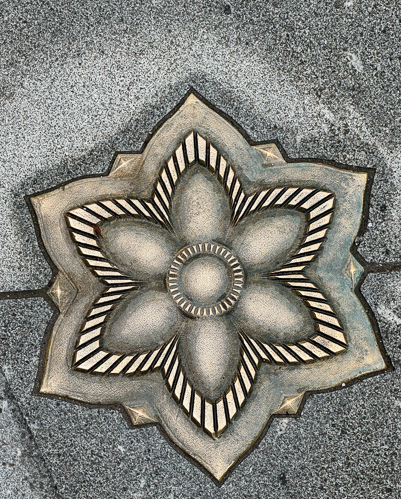
Cotton ball. Cotonopolis.
In 1781 Richard Arkwright opened the world’s first steam-driven textile mill in Manchester. His use of steam power was to raise water to turna waterwheel which powered the machines. The arrival of steam power was the beginning of the mechanization making Manchester the world’s first center of mass production and the world’s largest and most productive cotton spinning center.
This led Manchester to become the first industrial suburb centered on steam power, with architectural innovations that eventually included fireproofing by the use of iron and reinforced concrete.

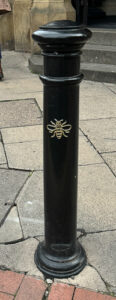
Busy as a Bee is a symbol of Manchester. Mancunians, as people from Manchester are called, have put bees on everything around town.
In the 18th and 19th centuries, Mancunian factories were sometimes referred to as beehives because their workers were so busy and productive.
This was how the bee first became associated with Manchester, and in 1842, it was officially incorporated into the Manchester coat of arms.
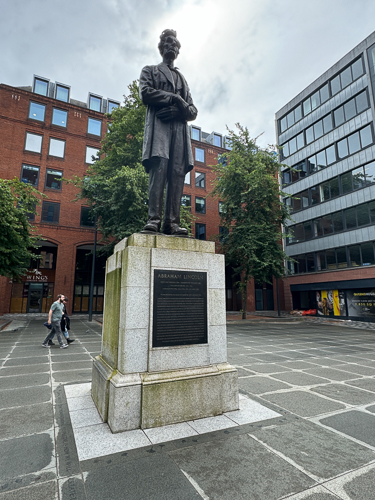 As the largest cotton processor in the world, Manchester took a strong moral and political stance by supporting Lincoln despite his blockade of the Confederate states beginning in April 1861. This measure drastically reduced supplies of cotton reaching Liverpool and, therefore, the cotton mills of Lancashire.
As the largest cotton processor in the world, Manchester took a strong moral and political stance by supporting Lincoln despite his blockade of the Confederate states beginning in April 1861. This measure drastically reduced supplies of cotton reaching Liverpool and, therefore, the cotton mills of Lancashire.
The aim, for Lincoln, was to out-maneuver the Confederate states, win the Civil War, and ultimately abolish the US slave trade.
However, Manchester and the surrounding area found that 60% of its mills were idle, largely because of the blockade.
Mill and shipping companies lobbied for the blockades to be destroyed, and opposition to the embargo and support for the Confederacy grew. However, in a meeting at the Manchester Free Trade Hall in 1862, workers agreed to maintain support for Lincoln and the embargo.
The meeting took place just as the cotton famine was beginning to cause serious distress across the country. US aid ships brought relief to starving mill workers as a gesture of gratitude.
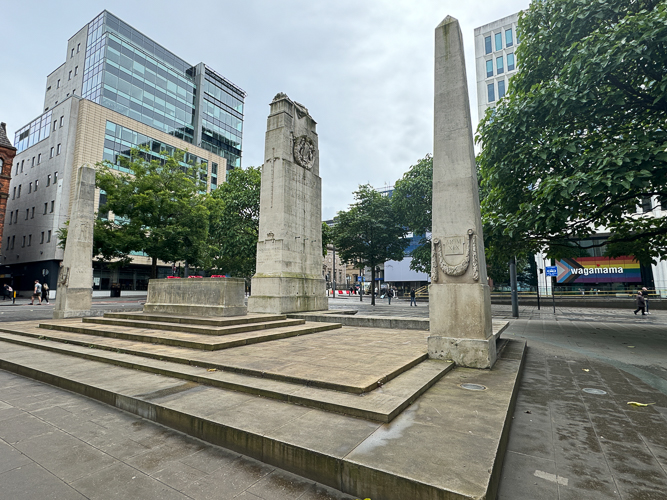
Manchester Cenotaph
Designed by Sir Edwin Lutyens, the cenotaph was built to remember the victims of WWI. It was not erected, however, until 1922. The memorial consists of a central cenotaph and a Stone of Remembrance flanked by twin obelisks.
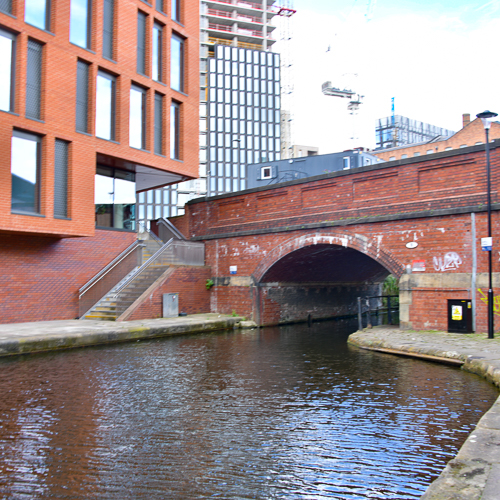
Before 1700, most British inland waterways had been built by aristocratic landowners to carry agricultural products in southern England. When the Duke of Bridgewater’s canal opened, he brought coal from his mines in Worsley to the center of Manchester in 1763, and the price of coal was halved overnight.
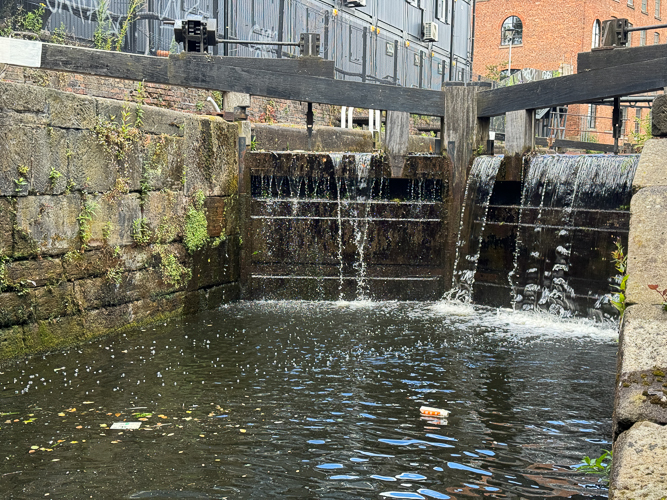
A lock of the canals of Manchester
The Bridgewater Canal, built in 1761 and designed by James Brindley and John Gilbert, was the first totally artificial waterway in Britain built separately from natural rivers.
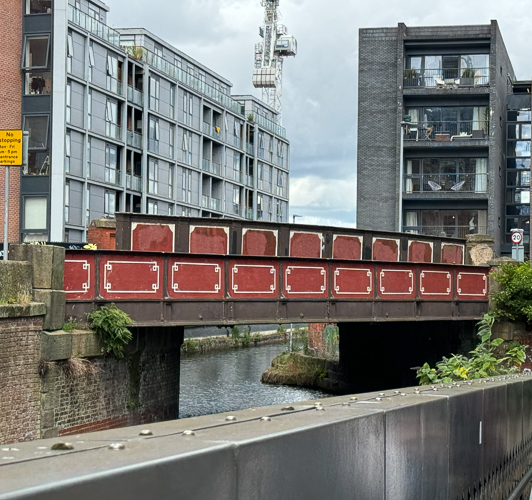
A bridge used by horses to cross the canal when the towpath changed sides
Thanks to these canals, the volume of goods carried increased rapidly, making Britain the first industrial power in the world. As a result, a vast number of people moved from the country to the town, completely changing the face of British society.
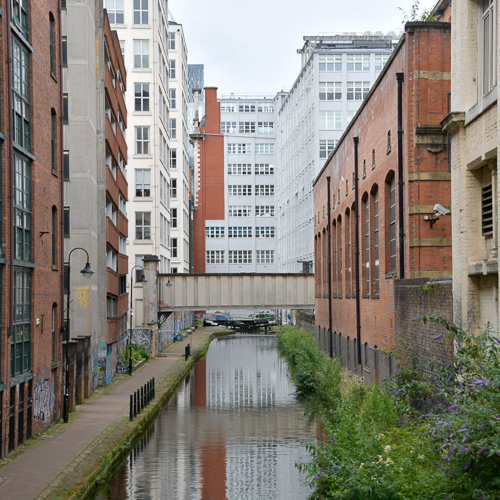
Walkway between warehouses on the Manchester Canals
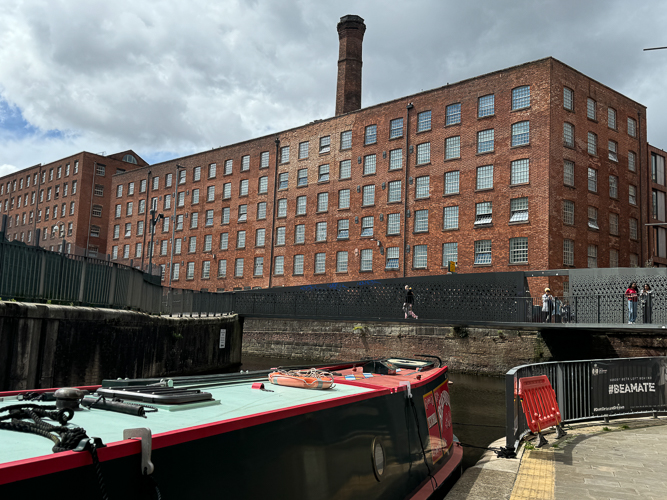
Murray Mills Manchester
Murray Mills would transform the world. The first mill on the site, Old Mill, was begun in 1797 and is the world’s oldest surviving urban steam-powered cotton spinning factory. The Old Mill was a purpose-built steam-powered spinning mill. After the canal’s completion to feed the area, coal, and cotton could be moved directly into the complex, and there was a readily available water supply for the steam engines from the private basin on the canal. By 1806, the Murrays’ Mills was the largest mill complex in the world, with 84,000 mule spindles compared to the others with a mere 10,000 spindles.

Lancaster House was a packing and shipping warehouse built between 1905 and 1910 for Lloyd’s Packing Warehouses Limited. Built in the Edwardian Baroque style, it had a steel frame and was clad with granite at the base, Accrington red brick, and orange terracotta. The building was designed by Harry S. Fairhurst, who had become “the leading expert in the design of these advanced warehouses.”
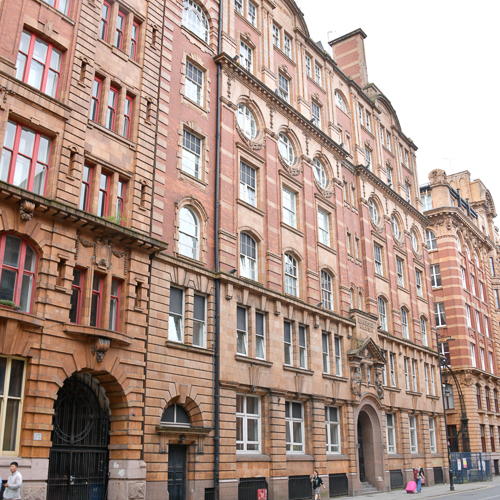
Lancaster House
Accrington bricks are iron-hard engineering bricks produced from 1887 to 2008. They were famed for their strength and called NORI. The stories of how they got that name are unknown, but the most common is that it was simply the word Iron, accidentally stamped backward.
Many of the warehouses in Manchester were for Textile Packaging rather than manufacturing. They not only held items for storage but also had offices, showrooms, and areas for quality control and the preparation and packing of cloth for transport.
Instead of multiple areas for loading, there was usually a small number less prominently placed in secure yards or wells. Loading would be aided by cranes, as seen in red below.
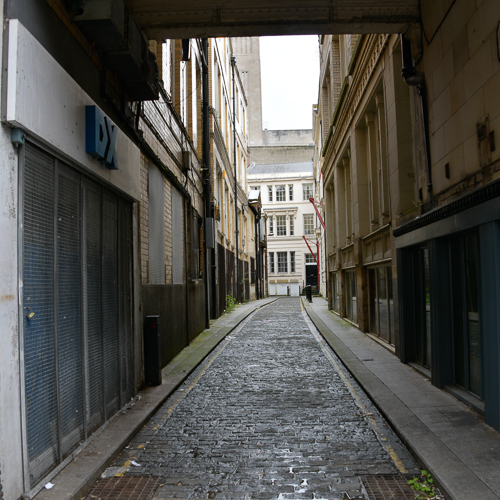
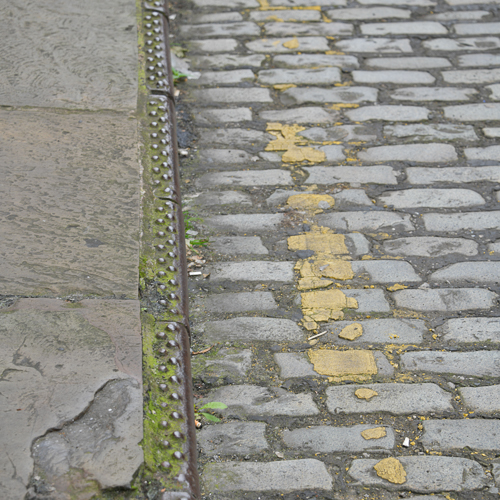
Steel rails placed in the sidewalks and loading areas acted as a braking system for the lorries carrying goods in and out of warehouses.
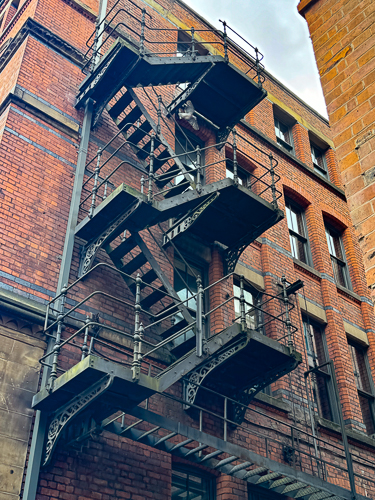
Lovely iron exterior stairways of warehouses
The cobbles of Manchester’s streets are called setts. Fleet Street in London was the busiest street in the world at the time, and due to wear and tear, the setts there had to be replaced every ten years.
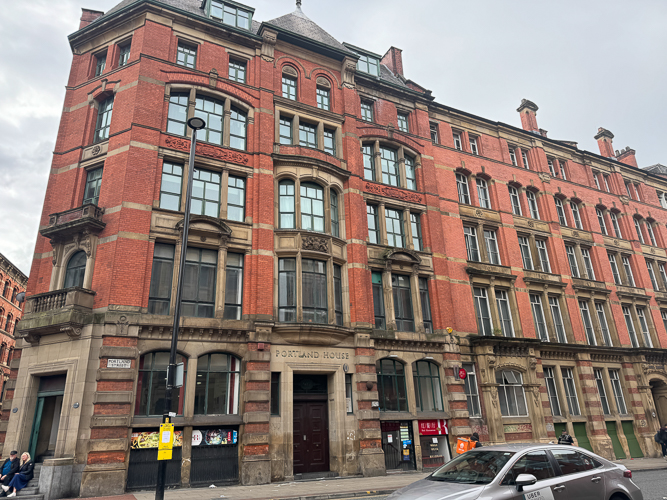
Large windows provided as much light as possible in the warehouse rooms where cloth was displayed so customers could check for flaws in weaving and printing.
Merchants vied with each other to impress, so the buildings were often built in the Italianate style rather than the utilitarian facades one thinks of with warehouses.
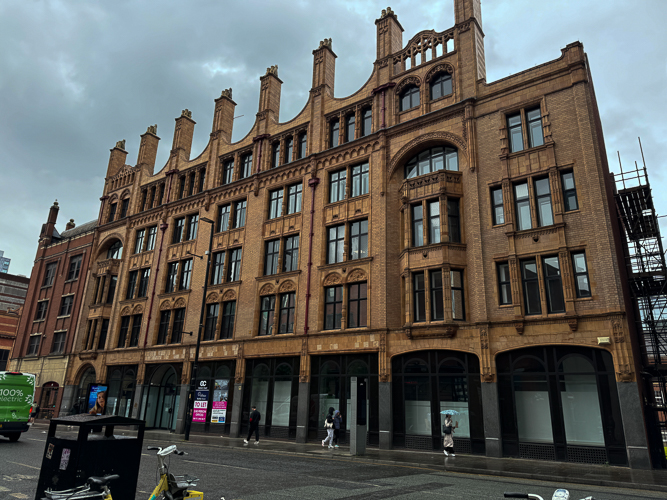
The Princess building, built as offices, shops, and warehousing in 1903 by I.R.E. Birkett
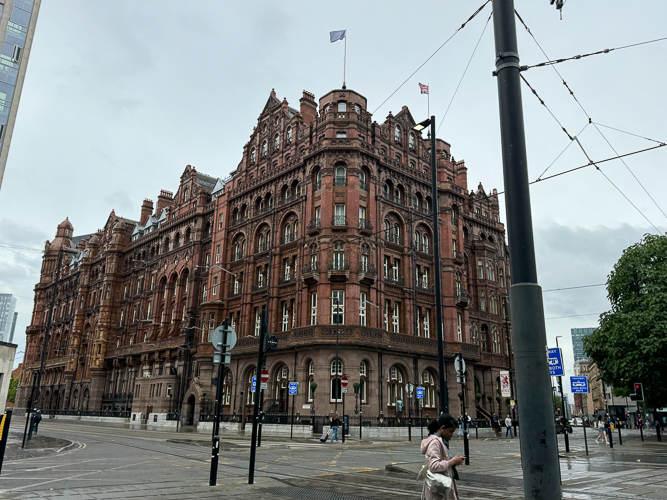
The Midland Hotel
The Midland Hotel opened in 1903 and was built by the Midland Railway to serve Manchester Central railway station, its northern terminus for its rail services to London St Pancras. It was designed by Charles Trubshaw in the Edwardian Baroque style.
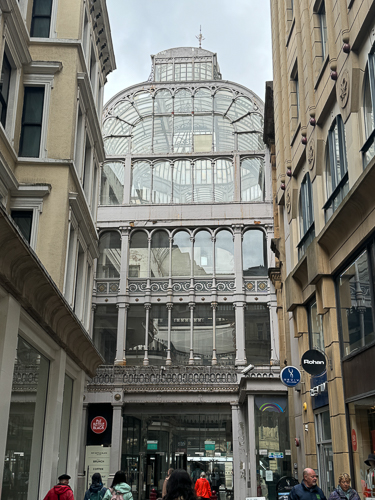
Barton Arcade
Barton’s Building façade was once described as “utterly ignorant… the ground floor pilasters must be seen to be believed.” The arcade, however, is “a gorgeous glass and iron shopping arcade with glass domes…, the best example of this type of cast-iron and glass arcade anywhere in the country.”
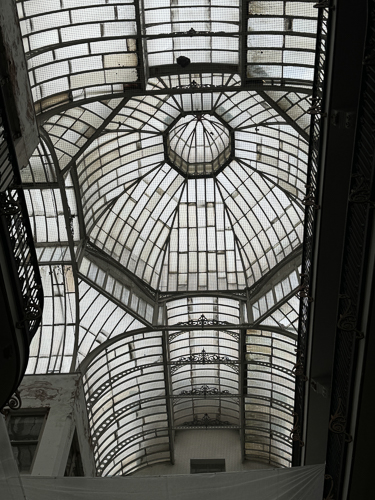
The interior of the arcade
The entrance to the arcade on St Ann’s Square incorporates a large cast iron and glass wall. The structure is composed of cast iron and glass, with the ironwork supplied by the Saracen Foundry in Glasgow.
John Rylands Library
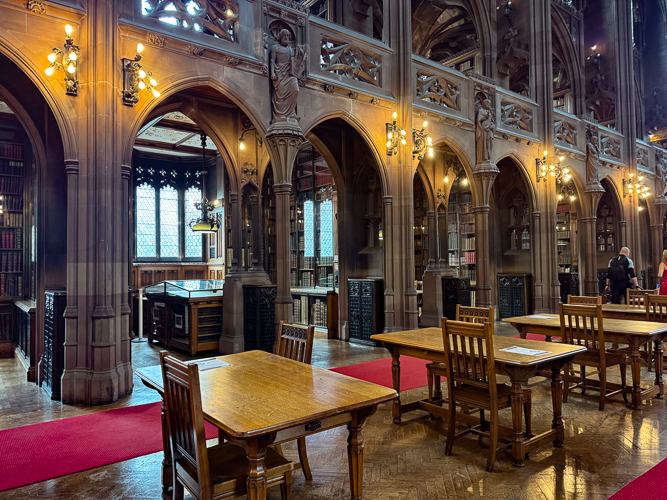
The Reading Room – Much of the original furniture designed by the architect can be seen on this floor.
The John Rylands Research Institute and Library is a late-Victorian neo-Gothic building. The library, which opened to the public in 1900, was founded by Enriqueta Augustina Rylands in memory of her husband, John Rylands. The library was built on a design from architect Basil Champneys.
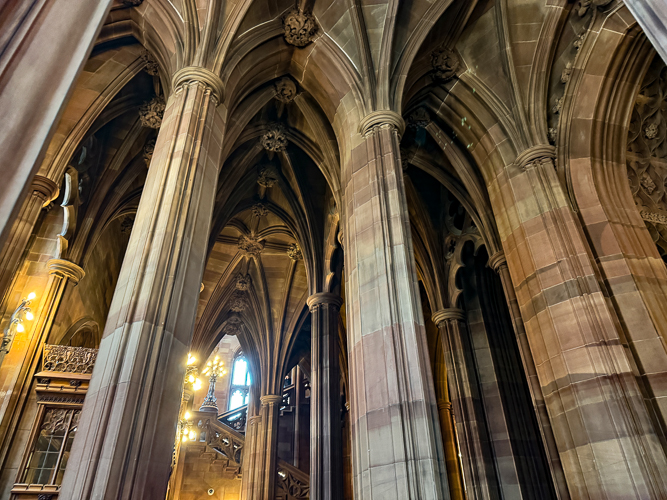
An idea of the elegance of the interior of the library
Refuge Assurance Building
The Refuge Assurance Building is now the Kimpton Hotel
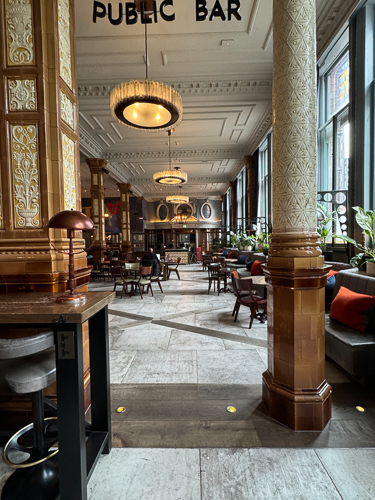
Interiors of the Refuge Assurance Building
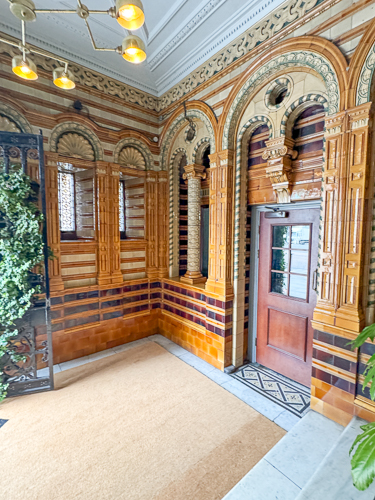
Interiors of the Refuge Assurance Building
The building was designed by Alfred Waterhouse and built between 1891 and 1895
Kendal Milne Store
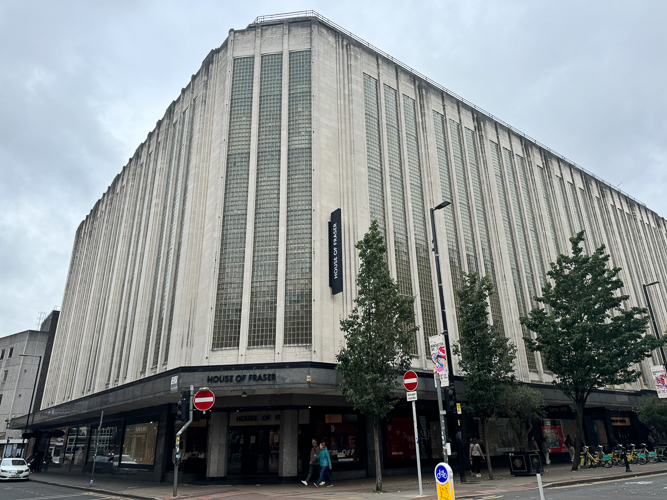
1939 Art Deco store
The modern building shown above was a store opened as Watts’ in 1832, later to become Kendal, Milne & Faulkner when three employees bought out the business and re-opened it in 1836. It was purchased by Harrods in 1919 and was called Harrods in the 1920s, but the name reverted to Kendal Milne following protests from customers and staff.
The present store was designed by Harrods’ in-house architect, Louis David Blanc, with input from a local architect, J. S. Beaumont, in 1938 as a purpose-built Art Deco retail space.
The Royal Exchange
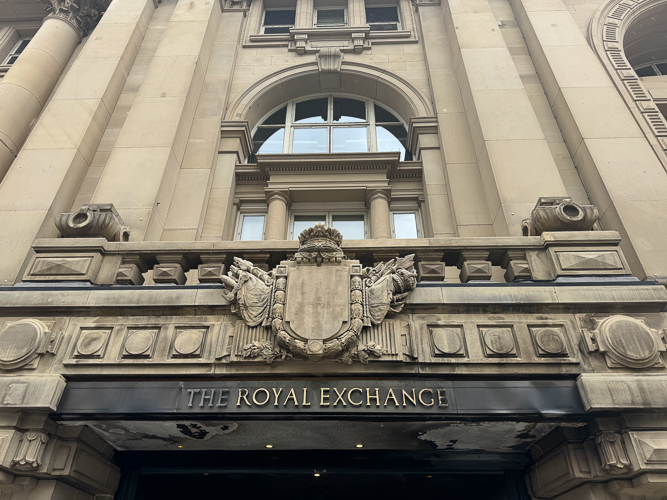
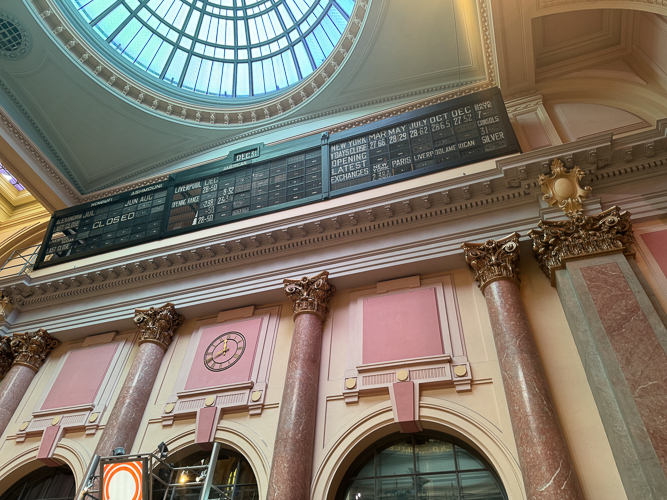
Royal Exchange Cotton Trading Board
The Royal Exchange was heavily damaged in the Manchester Blitz and the 1996 Manchester bombing. The building is the last of several buildings used for commodities exchange, primarily but not exclusively for cotton and textiles. It has been converted into a theater and entertainment center.
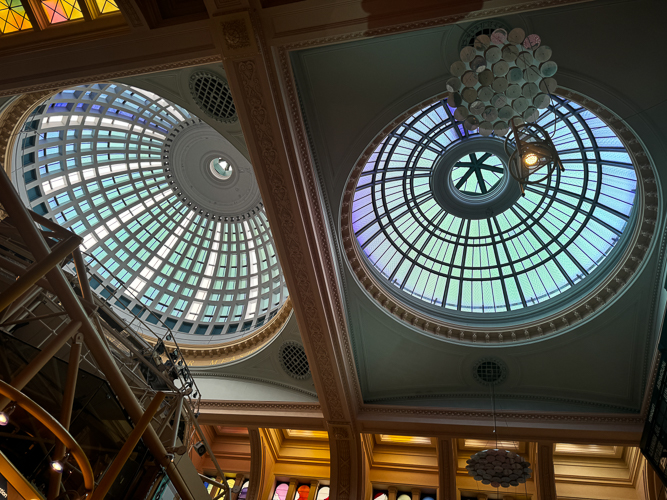
Interior domes of the Royal Exchange
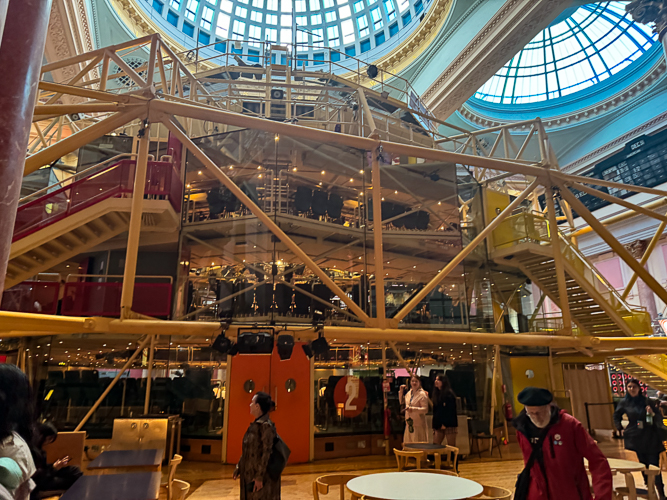
Theater inside the Royal Exchange

The Portico Library
The Portico Library is an independent subscription library designed in the Greek Revival style by Thomas Harrison and built between 1802 and 1806.
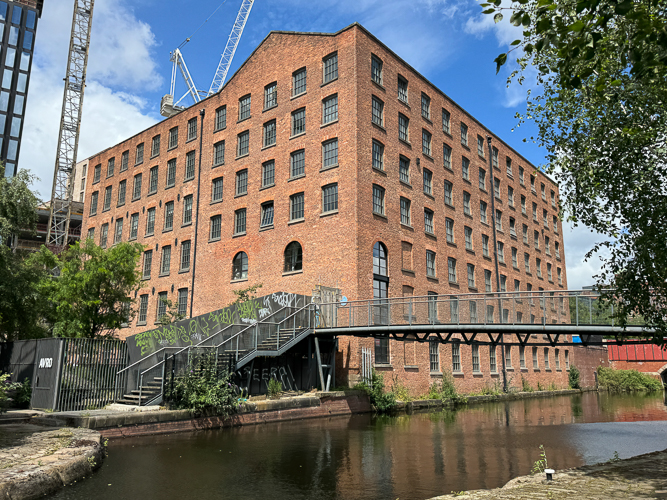
AV Roe, a Manchester man, designed and flew the first totally British airplane in 1908. Based in this mill – The Brownsfield Mill – Roe pioneered the enclosed cockpit and single joystick and formed the world’s first company registered as an airplane manufacturer. He ran the first scheduled domestic passenger service in Britain in May 1919. In 1928, one of his planes became the first to complete a solo flight to Australia.
Canal Basins of Manchester
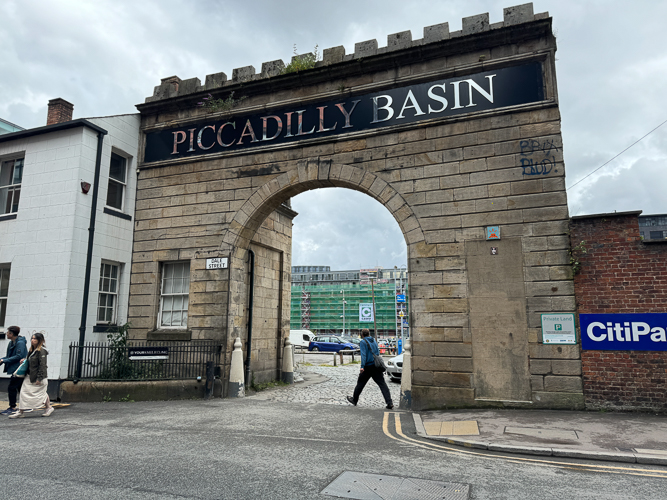
Gateways such as this were built to let you know the canal basins were not for the public. – This was a warehouse area with goods waiting to be shipped down the canals to market.
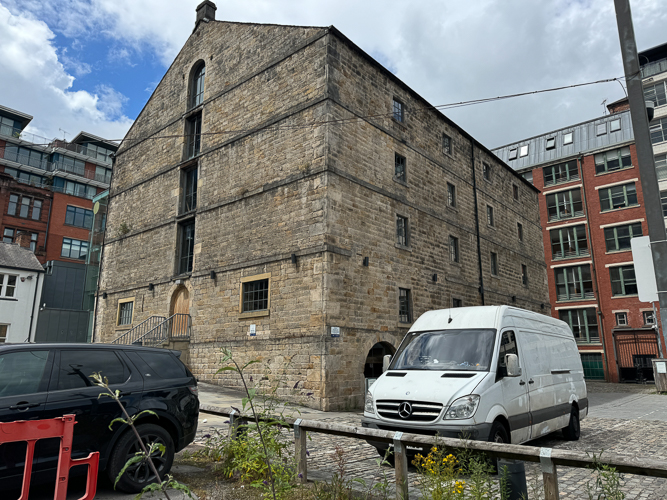
Dale Street Warehouse
The Dale Street warehouse is the earliest surviving canal warehouse in Manchester. The building is dated 1806 and was designed by William Crosley, an engineer who worked with William Jessop on the inner Manchester canal system.

The base of the building incorporates four boatholes, which allowed boats to unload their cargo inside of the warehouse.
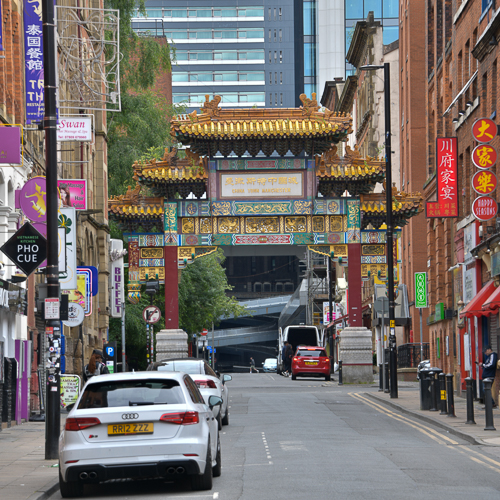
Chinatown in Manchester is the second largest in the UK and the third largest in Europe. Its archway was completed in 1987 on Faulkner Street.
Whitworth Hall
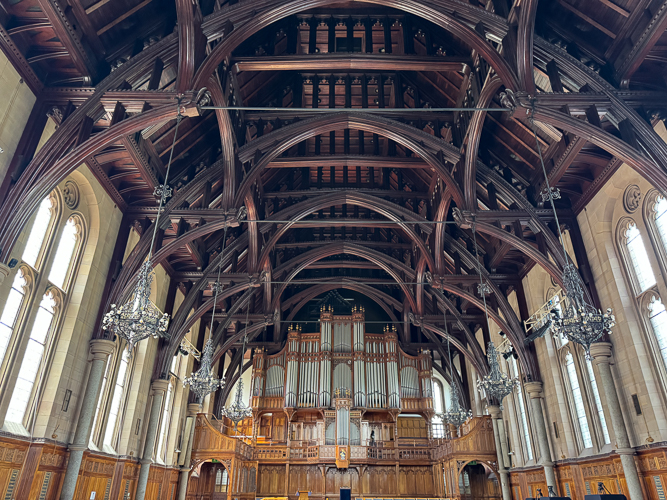
Whitworth Hall was constructed c. 1895–1902 in the style of the Gothic Revival and was designed by Paul Waterhouse.
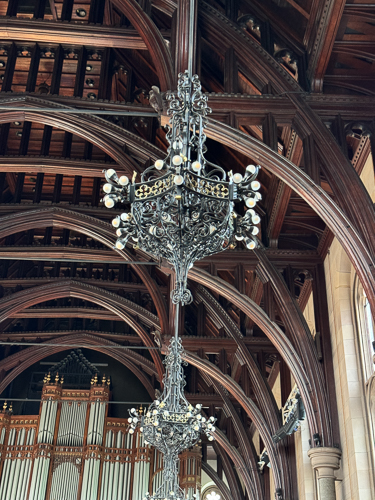
The chandelier in Whitworth Hall
Odds and Ends around Manchester
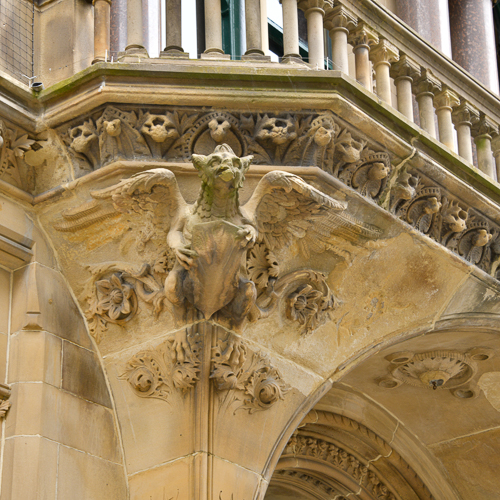 *
*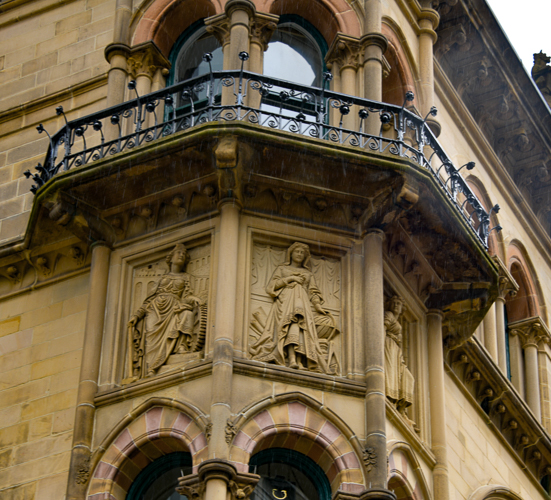 *
*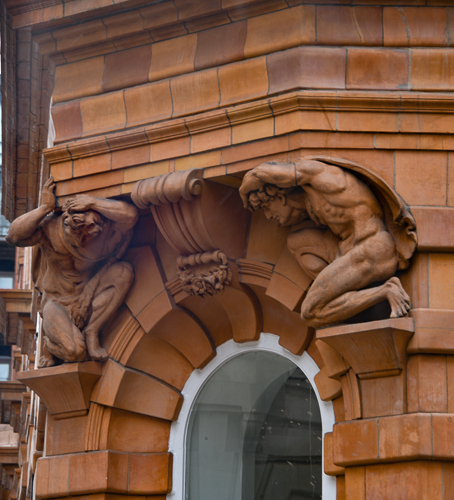
Contact is an arts organization established in 1972 as a center for young artists to create and learn.
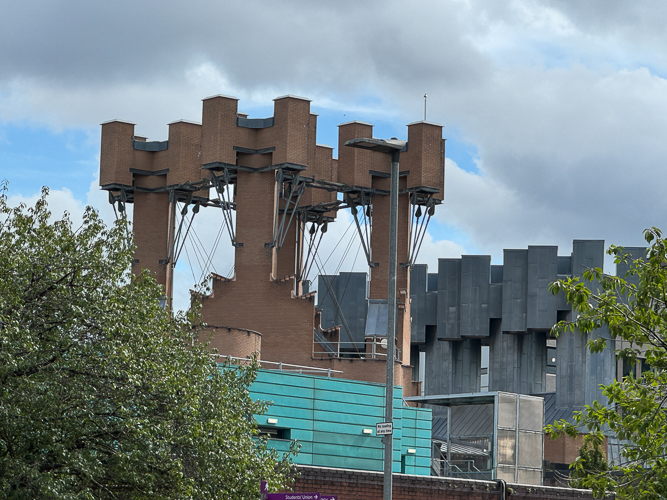
It would take a lifetime to discover the city of Manchester and its incredible history. I had one day.